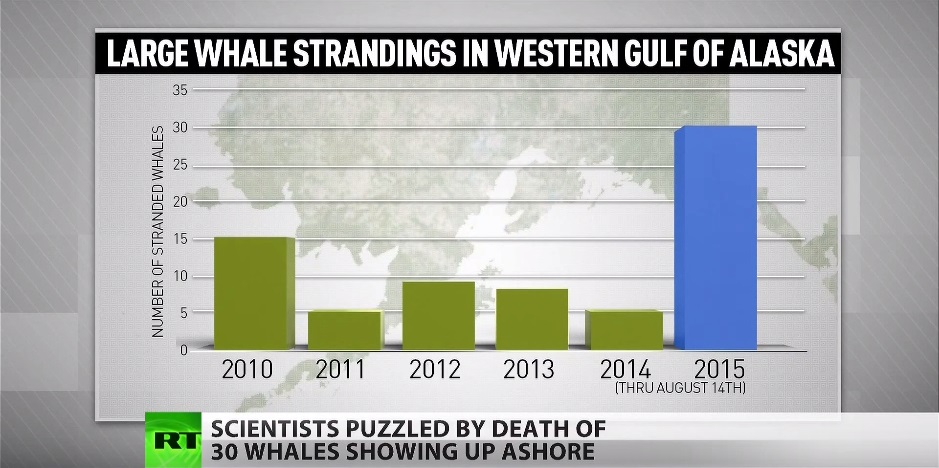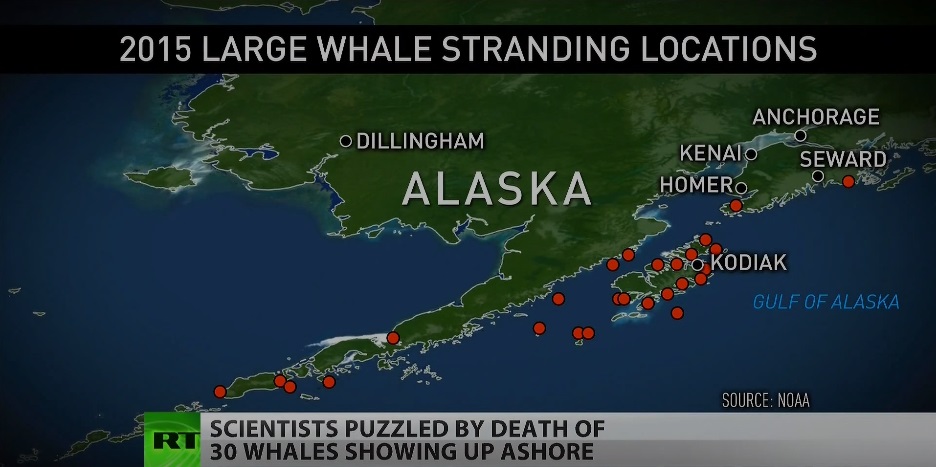
This summer has been filled with some unusual phenomenon within the marine world, from recent footage of stone fish battling it out with sea snakes to gigantic oarfish washing ashore with 7ft long ovaries. But nothing has yet been comparable to the 30 dead whales that have washed ashore on Alaskan coasts without an obvious explanation.
Official investigations have been carried out by the University of Alaska and the National Oceanic and Atmospheric Administration (NOAA), to ultimately find out what could be causing this “unusual mortality event.” Among the dead are 11 finback whales, 14 humpbacks, 1 grey whale and 4 species of cetacean that have yet to be identified.

The leading theory that NOAA, and organisations such as the NorthWest Fisheries Science Centre, have on the occurrence is that various extensive offshore surveys over the west coast of America have given an indication that there has been an increase of harmful algal blooms. These algal blooms span much of the west coast and involve some of the highest concentrations of the natural toxin demoic acid ever observed. This data has also caused the closure of many shellfisheries along the west coast.
Although the acid in itself is not externally toxic to the whales, once consumed through the food chain— ingesting copious amounts of organisms that feed on the acidic phytoplankton— does it then becomes toxic. To put that in perspective, in cold waters, a humpback whale consumes an average of up to 5,500 pounds of plankton, krill, small fish and even squid daily.
According to the NOAA, the 30 deaths that have occurred over the summer period, between May and August, have amounted to three times the historical average. There has been many other sightings of floating carcasses; however, they have either been deemed un-obtainable or have been scavenged by other marine species. Ultimately, this has made it increasingly difficult to determine the cause of these unusual deaths.

One case of the incident was particularly puzzling states marine mammal specialist, Kate Wynne, as many as 9 of the 11 finback whales that were found were within a small vicinity of each other around Kodiak Island.
According to reports, it could take years to obtain any significant data for the investigation. Since 1991, 29 out of 61 investigations on unusual deceased animals have been conclusive. To fully research and study this, samples need to be taken from the regions and from each of the carcasses.
Dr Rowles states that, “Trying to investigate large whale mortality events provides a lot of logistical complications, including getting access to good samples, getting access safely to carcasses and even finding a place for the carcasses to be towed and examined,” not to mention extensive studying of samples of the toxic phytoplankton.
In addition, over the past few years, similar accounts have also been recorded along the west and east coast of America. Although the species were different for these cases, they shared comparable results. In 2013, 59 bottlenose dolphins washed ashore on east coast of Florida and seabirds suffered from a high mortality rate in early June. So far, causes of these events also remain undetermined.
This Article (Scientists Link Toxic Bloom With 30 Whale Deaths off Alaska) is free and open source. You have permission to republish this article under a Creative Commons license with attribution to the author and AnonHQ.com.




